8-6 Comets come from far out in the solar system
In the first few hundred million years of the solar system’s existence, comets formed in its outer reaches at roughly the distances of Saturn, Uranus, and Neptune. In that region, water was plentiful and the temperature was low enough for the ices to condense into chunks several kilometers across. After they formed, gravitational tugs from Uranus and Neptune flung the comets in every direction, as we saw in Section 4-5.
In 2001, astronomers were able to measure the temperature at which ammonia ice formed in Comet LINEAR (named after the Lincoln Near Earth Asteroid program that discovered it). This temperature determines the ammonia’s solid structure, and by determining the structure of the ammonia in Comet LINEAR, scientists were able to calculate the temperature when it formed and therefore how far the comet was from the Sun at that time. That comet coalesced between the present orbits of Saturn and Uranus.
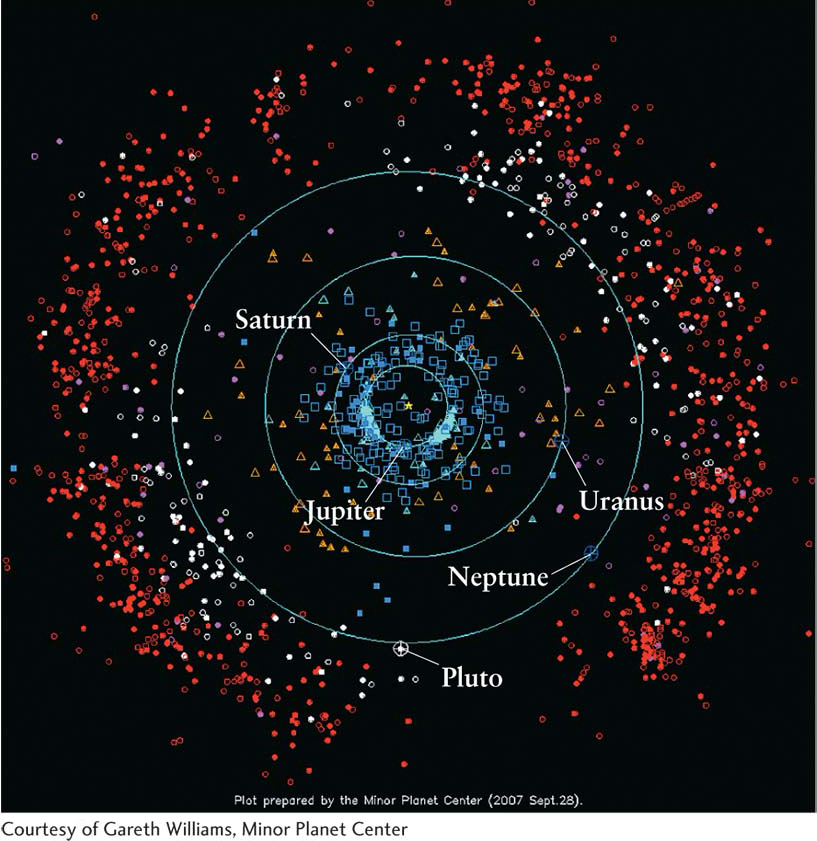
Figure 8-20: Current Positions of Known Dwarf Planets and SSSBs in the Outer Solar System Objects with unusually high eccentricity orbits are shown as cyan triangles. Objects roaming among the outer planets, called centaur objects, are orange triangles. Plutinos are white circles. Miscellaneous objects are magenta circles, and classical KBOs are red circles. Objects observed only once are denoted by open symbols; objects with two separate observations are denoted by filled symbols. Comets are filled and unfilled light-blue squares.
The solar system is believed to contain two reservoirs of comets, the donut-shaped Kuiper belt and the spherical Oort cloud, from which some comets are nudged toward the inner solar system by near misses between them (see Figure 4-6). Indeed, such near misses are the primary source of comets in the realm of the planets.
The Kuiper belt (Figure 8-20) is centered on the plane of the ecliptic. Its main body of objects extends out some 50 AU from the Sun. (Recall that Neptune orbits at 30 AU from the Sun.) Astronomers believe most comets entering the inner solar system come from the Kuiper belt because most of these comets have orbits relatively close to the plane of the ecliptic. If most comets came from the spherical Oort cloud, the planes of their orbits when near the Sun would be random, with most located far from the plane of the ecliptic.
The Kuiper belt objects were first discovered in 1992 and they fall into two groups. Those with roughly circular orbits are called classical KBOs and are found between 30 AU and 50 AU from the Sun. Objects in the second group, called scattered KBOs, have more elliptical orbits that range from 35 AU to at least 200 AU from the Sun. More than 1500 KBOs have been observed (Figure 8-20 and Figure 8-21). Although most of the observed KBOs are tens of kilometers across, astronomers have also begun to observe some KBOs only 10 to 100 m in diameter. Based on these latter observations, astronomers estimate that 1015 such objects exist out there.

Figure 8-21:  Kuiper Belt Objects (a, b) These 1993 images show the discovery (bracketed by white lines) of one of at least 1524 known KBOs. These two images of KBO 1993 SC were taken 4.6 hours apart, during which time the object moved against the background stars. (c) The KBO 1998 WW31 and its moon (lower left).
Kuiper Belt Objects (a, b) These 1993 images show the discovery (bracketed by white lines) of one of at least 1524 known KBOs. These two images of KBO 1993 SC were taken 4.6 hours apart, during which time the object moved against the background stars. (c) The KBO 1998 WW31 and its moon (lower left).
At least 1% of the KBOs are orbiting pairs (Figure 8-21c), including Quaoar, which is 1250 km (775 mi) across, some 400 km (250 mi) larger than Ceres or about half the size of Pluto. At least 122 of the KBOs orbit the Sun in the same region as Pluto. These latter bodies are also called plutinos (Section 4-5). The period of Neptune’s orbit around the Sun is two-thirds as long as the orbital periods of Pluto and the plutinos. Indeed, it appears that Pluto and the plutinos were forced into their present orbit by Neptune’s gravity. Thus, astronomers say that plutinos are locked into a 2:3 resonance with Neptune.
The vast majority of comets, estimated between 0.1 and 2 × 1012 bodies, are believed to lie even farther from the Sun. Unlike the Kuiper belt comets and the rest of the solar system, these bodies are believed to have a spherical distribution around the Sun, called the Oort cloud (Figure 4-6), named after the Dutch astronomer Jan Oort, who first proposed its existence in the 1950s. The Oort cloud extends from roughly 5000 to 100,000 AU from the Sun. In other words, the outer edge of the Oort cloud is some two-fifths the distance to the star nearest to the solar system.
In 2003, astronomers discovered an object that orbits between the Kuiper belt and Oort cloud. Larger than Quaoar, Sedna is roughly 1800 km (1100 mi) across and is presently 86 AU from the Sun. Sedna has a highly elliptical orbit (Figure 8-22) that takes it from 76 to 937 AU. It has a sidereal rotation period of 10 hours and it is presently the farthest known KBO from the Sun.

Figure 8-22: Sedna’s Orbit (a) The farthest known body in the solar system is in a highly elliptical orbit (b) that orbits between the Kuiper belt and the Oort cloud.
Most comets have orbits sufficiently circular that they never even get as close as Pluto is to the Sun. However, occasionally a near miss between two comet nuclei nudges a distant comet toward the inner solar system. As a result of its inward plunge, comets from the Oort cloud, like Hale-Bopp and Hyakutake, have highly elliptical, parabolic, or even slightly hyperbolic orbits (see Section 2-8). Often Oort cloud comets also have orbits that are highly tilted, even perpendicular, to the plane of the ecliptic.
Focus Question 8-4
What is the solid part of a comet called?
Focus Question 8-5
What is the composition of a comet?
Because the comets in the Kuiper belt and Oort cloud are far from the Sun, they are completely frozen. Solid cometary bodies, called nuclei (singular, nucleus), are typically between 1 and 10 km (0.6 to 6 mi) across, although some, like that of Comet Halley, are 15 km (9 mi) or more in diameter. The first pictures of a comet’s nucleus (Figure 8-23a) were obtained when a fleet of spacecraft flew past Comet Halley in 1986. Halley’s potato-shaped nucleus is darker than coal, probably because of carbon-rich compounds left behind as ice evaporates. In 2010, NASA’s EPOXI spacecraft flew past Comet Hartley 2, imaging an overactive body emitting primarily carbon dioxide vapor and water ice out its ends and water vapor out its sides (Figure 8-23b). These emissions occur on the sides of the comet facing the Sun. Astronomers believe that the water ice is dragged out by the carbon dioxide gas. All these emissions make Hartley 2 the most complex comet observed so far.

Figure 8-23:  Comet Nuclei (a) This image, taken by the Giotto spacecraft, shows the potato-shaped nucleus of Comet Halley. Its dark nucleus measures 15 km (9 mi) in its longest dimension and about 8 km (5 mi) in its shortest. The numerous bright areas on the nucleus are icy outcroppings that reflect more sunlight than surrounding areas of the comet. Two jets of gas can be seen emanating from the left side of the nucleus. (b) The nucleus of Hartley 2 is 2 km (1.2 mi) long. It spins on its short axis once every 18 hours, while tumbling around its long axis.
Comet Nuclei (a) This image, taken by the Giotto spacecraft, shows the potato-shaped nucleus of Comet Halley. Its dark nucleus measures 15 km (9 mi) in its longest dimension and about 8 km (5 mi) in its shortest. The numerous bright areas on the nucleus are icy outcroppings that reflect more sunlight than surrounding areas of the comet. Two jets of gas can be seen emanating from the left side of the nucleus. (b) The nucleus of Hartley 2 is 2 km (1.2 mi) long. It spins on its short axis once every 18 hours, while tumbling around its long axis.
To better determine the composition of the gas emitted by comets, the Stardust probe visited Comet Wild 2 (pronounced vilt 2), where it collected samples and returned them to Earth in 2006 (Figure 8-24). Among the most interesting discoveries was the presence of amino acids, the building blocks of proteins upon which terrestrial life is based. Comet Wild 2 itself showed many unexpected features, including towering spires, many craters and cliffs, and more than 24 jets, rather than the two or three jets seen on other comets.
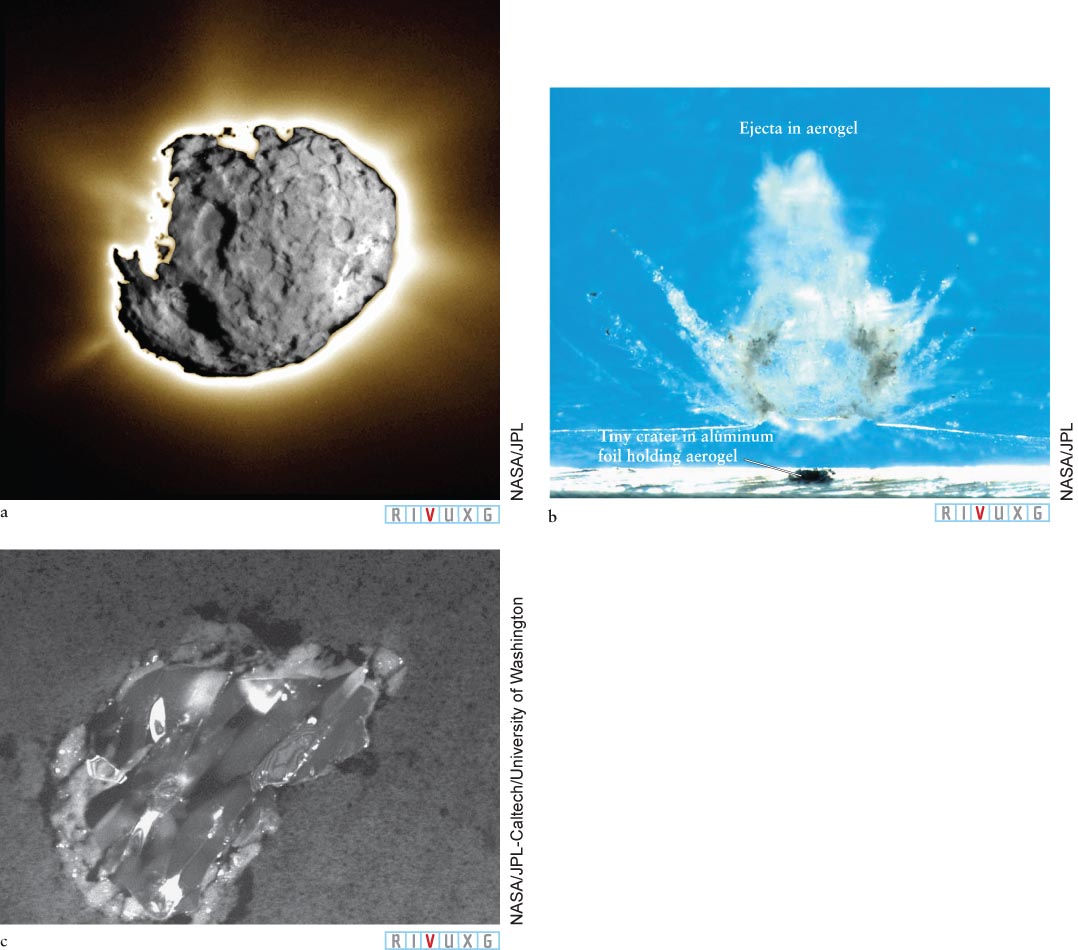
Figure 8-24: 

 Comet Wild 2 (a) This picture shows two images combined. One is a high-resolution photograph showing the surprisingly heavily cratered comet. The other image is a longer photograph showing gas and dust jetting from the comet. Its tails are millions of kilometers long. (b) A substance called aerogel was used to capture particles from Comet Wild 2’s dust tail. A piece of space debris pierced the aluminum foil holding the aerogel and embedded in it, along with pieces of the foil. (c) A 2-μm piece of comet dust, composed of a mineral called forsterite. On Earth this mineral is used to make gems called peridot.
Comet Wild 2 (a) This picture shows two images combined. One is a high-resolution photograph showing the surprisingly heavily cratered comet. The other image is a longer photograph showing gas and dust jetting from the comet. Its tails are millions of kilometers long. (b) A substance called aerogel was used to capture particles from Comet Wild 2’s dust tail. A piece of space debris pierced the aluminum foil holding the aerogel and embedded in it, along with pieces of the foil. (c) A 2-μm piece of comet dust, composed of a mineral called forsterite. On Earth this mineral is used to make gems called peridot.
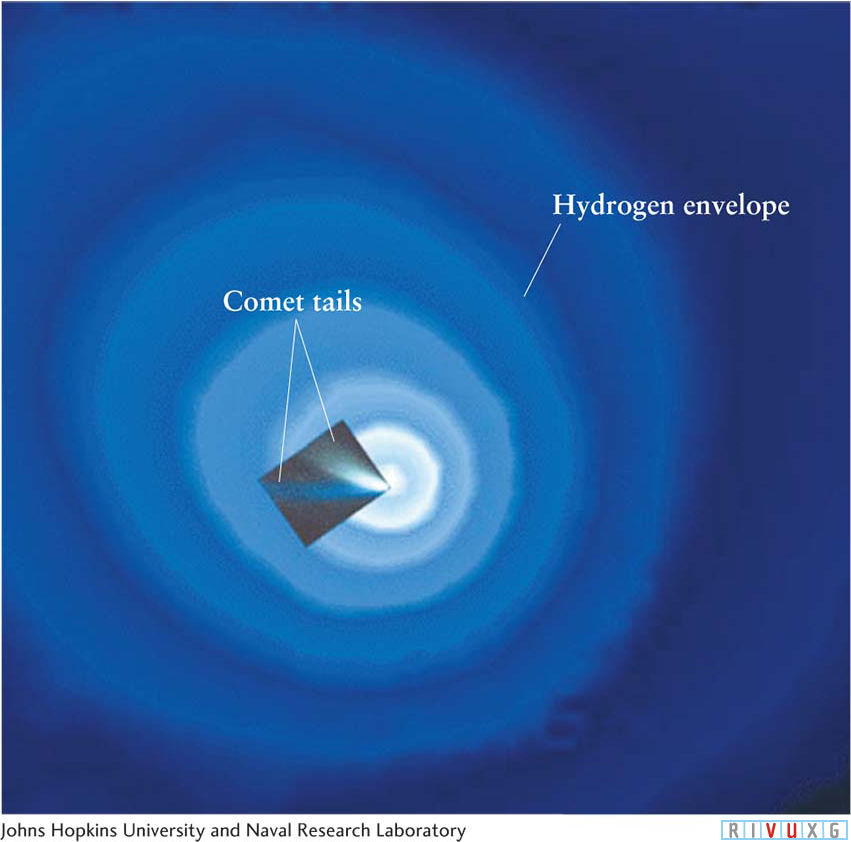
Figure 8-25:  Comet Hale-Bopp In 1997, Comet Hale-Bopp had a hydrogen envelope 1 AU in diameter (blue ovals). This gas was observed in the ultraviolet. The visible-light inset shows the scale of the visible tails (see also the image at the opening of this chapter).
Comet Hale-Bopp In 1997, Comet Hale-Bopp had a hydrogen envelope 1 AU in diameter (blue ovals). This gas was observed in the ultraviolet. The visible-light inset shows the scale of the visible tails (see also the image at the opening of this chapter).
When a comet nucleus comes within 20 AU of the Sun, solar radiation begins to sublimate (change directly from solid to gas) the ices on its surface. The liberated gases form an atmosphere, or coma, around the nucleus. Because the coma scatters sunlight, it appears as a fuzzy, luminous ball. The largest coma ever measured was that of Comet Holmes, which in 2007 near its perihelion was 1.4 million kilometers (870 thousand mi) across—larger than the Sun. Not visible to the human eye is the hydrogen envelope, a sphere of tenuous gas surrounding the comet’s nucleus and measuring as much as 20 million km (12 million mi) in diameter (Figure 8-25).
8-7 Comet tails develop from gases and dust pushed outward by the Sun

 The most visible and inspiring features of comets are their long, flowing, diaphanous tails (Figure 8-26). Comet tails develop from coma gases and dust pushed outward by radiation and particles from the Sun. Thus, comet tails do not trail behind the nucleus, as the exhaust from a jet plane does in Earth’s atmosphere. Rather, at the comet’s nucleus, the tails always point away from the Sun (Figure 8-27), regardless of the direction of the comet’s motion. The implication that something from the Sun “blows” the comet’s gases radially outward led Ludwig Biermann to predict the existence of the solar wind (see Section 6-5 and Section 9-3). This stream of particles from the Sun was actually discovered in 1962, a full decade after it was predicted, by instruments on the spacecraft Mariner 2. In 2001, NASA launched the Genesis spacecraft, which collected pristine solar wind particles for 2½ years. Although it crash-landed back on Earth in September 2004, some of the particles that it collected were salvaged and studied. From these, astronomers discovered that the chemistry of the Sun and the chemistry of Earth have important differences. In particular, the isotopes (see Section 3-16) of oxygen and nitrogen are found in different amounts on the two worlds. For example, when comparing the amount of 14N (nitrogen with 7 neutrons) and 15N (nitrogen with 8 neutrons), Earth has 40% more 15N than does the Sun. The reasons for this and other chemical differences are now being studied.
The most visible and inspiring features of comets are their long, flowing, diaphanous tails (Figure 8-26). Comet tails develop from coma gases and dust pushed outward by radiation and particles from the Sun. Thus, comet tails do not trail behind the nucleus, as the exhaust from a jet plane does in Earth’s atmosphere. Rather, at the comet’s nucleus, the tails always point away from the Sun (Figure 8-27), regardless of the direction of the comet’s motion. The implication that something from the Sun “blows” the comet’s gases radially outward led Ludwig Biermann to predict the existence of the solar wind (see Section 6-5 and Section 9-3). This stream of particles from the Sun was actually discovered in 1962, a full decade after it was predicted, by instruments on the spacecraft Mariner 2. In 2001, NASA launched the Genesis spacecraft, which collected pristine solar wind particles for 2½ years. Although it crash-landed back on Earth in September 2004, some of the particles that it collected were salvaged and studied. From these, astronomers discovered that the chemistry of the Sun and the chemistry of Earth have important differences. In particular, the isotopes (see Section 3-16) of oxygen and nitrogen are found in different amounts on the two worlds. For example, when comparing the amount of 14N (nitrogen with 7 neutrons) and 15N (nitrogen with 8 neutrons), Earth has 40% more 15N than does the Sun. The reasons for this and other chemical differences are now being studied.

Figure 8-27: The Orbit and Tails of a Comet The sunlight and solar wind blow a comet’s dust particles and ionized atoms away from the Sun. Consequently, comets’ tails always point away from the Sun.

Figure 8-26:  Comet West Astronomer Michael M. West first noticed this comet on a photograph taken with a telescope in 1975. After passing near the Sun, Comet West became one of the brightest comets of the 1970s. This photograph shows the comet in the predawn sky in March 1976.
Comet West Astronomer Michael M. West first noticed this comet on a photograph taken with a telescope in 1975. After passing near the Sun, Comet West became one of the brightest comets of the 1970s. This photograph shows the comet in the predawn sky in March 1976.
Outflowing particles and radiation from the Sun produce two comet tails: a gas (or ion or plasma) tail and a dust tail (Figure 8-28 and the figure opening this chapter). Positively charged ions (atoms missing one or more electrons) from the coma are swept directly away from the Sun by the solar wind to form the gas tail. Gas tails are composed primarily of water, carbon monoxide, carbon dioxide, methanol, formaldehyde, and ammonia. Such a tail often appears blue, because carbon monoxide ions in the gas strongly scatter blue light. The relatively straight gas tail can change dramatically from night to night (Figure 8-28a). These changes occur because the solar wind that pushes the gases changes rapidly and the gases themselves are very light and easily moved about, like the smoke from a fire (Figure 8-28b).
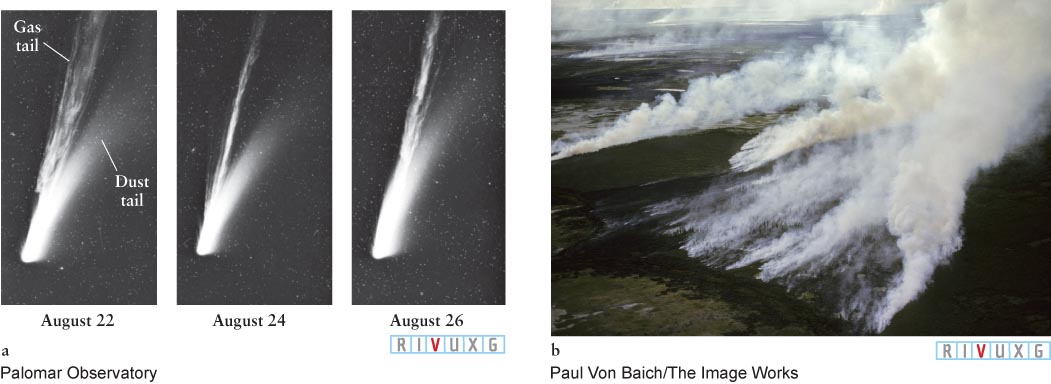
Figure 8-28: 
 The Two Tails of Comet Mrkos (a) Comet Mrkos dominated the evening sky in August 1957. These three views, taken at 2-day intervals, show dramatic changes in the comet’s gas tail. In contrast, the slightly curved dust tail remained fuzzy and featureless. (b) Wind blowing smoke from this forest fire causes the smoke column to change shape and direction, just like the solar wind and sunlight cause the tails of comets to change shape and direction.
The Two Tails of Comet Mrkos (a) Comet Mrkos dominated the evening sky in August 1957. These three views, taken at 2-day intervals, show dramatic changes in the comet’s gas tail. In contrast, the slightly curved dust tail remained fuzzy and featureless. (b) Wind blowing smoke from this forest fire causes the smoke column to change shape and direction, just like the solar wind and sunlight cause the tails of comets to change shape and direction.

Figure 8-29: The Structure of a Comet The solid part of a typical comet (the nucleus) is roughly 10 km in diameter. The coma can be as large as 105 to 106 km across, and the hydrogen envelope is typically 107 km (6 million mi) in diameter. A comet’s tail can be enormous—even longer than 1 AU. Comet Wild 2 (inset) is examined further in Figure 8-24. (This drawing is not to scale.)
The dust tail is formed when sunlight strikes dust particles that have been freed from the comet’s evaporating nucleus. Light exerts pressure on any object that absorbs or scatters it. While this pressure, called radiation pressure or photon pressure, is quite weak, fine-grained dust particles in a comet’s coma are sufficiently light to be pushed from the vicinity of the comet, thus producing a dust tail. The dust tail is often white or light gray. The dust particles are massive enough not to flow straight away from the Sun; rather, the dust tail arches in a path that lies between the gas tail and the direction from which the comet came (see Figure 8-27, Figure 8-28, and Figure 8-29). Even though gas tails of most comets appear significantly brighter and often longer than dust tails and other rocky debris, observations reveal that about 3 times as much mass leaves a typical comet in the form of dust and rocks than leaves as gas.
Insight Into Science
Starting with Observations Science often advances by working from observations and experiments requiring scientific explanations. For example, seeing comet tails and how they behave led Biermann to wonder what causes them. The simplest physical explanation is that matter from each cometary body is being evaporated and pushed upon by something from the Sun—the solar wind. Remember Occam’s razor (Section 2-1).
Focus Question 8-6
Which comet tail points directly away from the Sun, and why?
Figure 8-29 outlines the elements of comets, although many have bigger or smaller versions of these features. For example, some comets, like the one shown in Figure 8-30, have a large, bright coma but short, stubby tails. Others have an inconspicuous coma but one or more tails of astonishing length. The gas tail in Figure 8-31 stretches more than 150 million km (1 AU) in length.
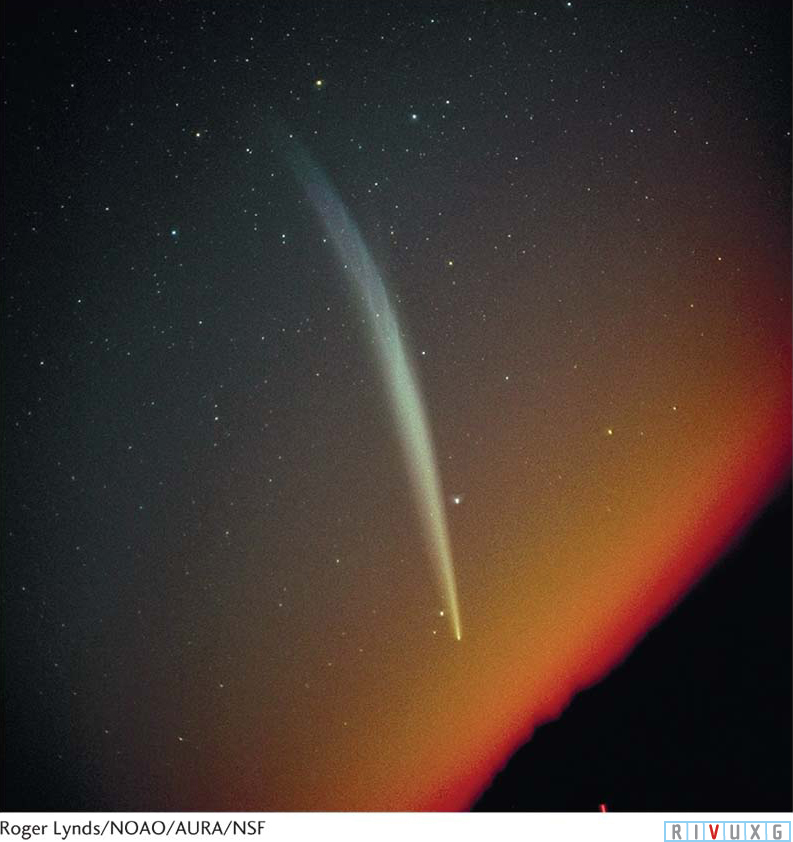
Figure 8-31:  The Tail of Comet Ikeya-Seki Named after its codiscoverers in Japan, this comet dominated the predawn skies in late October 1965. The yellow in the tail comes from emission by sodium atoms in the dust that was released by the comet. Although its coma was tiny, its tail spanned over 1 AU.
The Tail of Comet Ikeya-Seki Named after its codiscoverers in Japan, this comet dominated the predawn skies in late October 1965. The yellow in the tail comes from emission by sodium atoms in the dust that was released by the comet. Although its coma was tiny, its tail spanned over 1 AU.
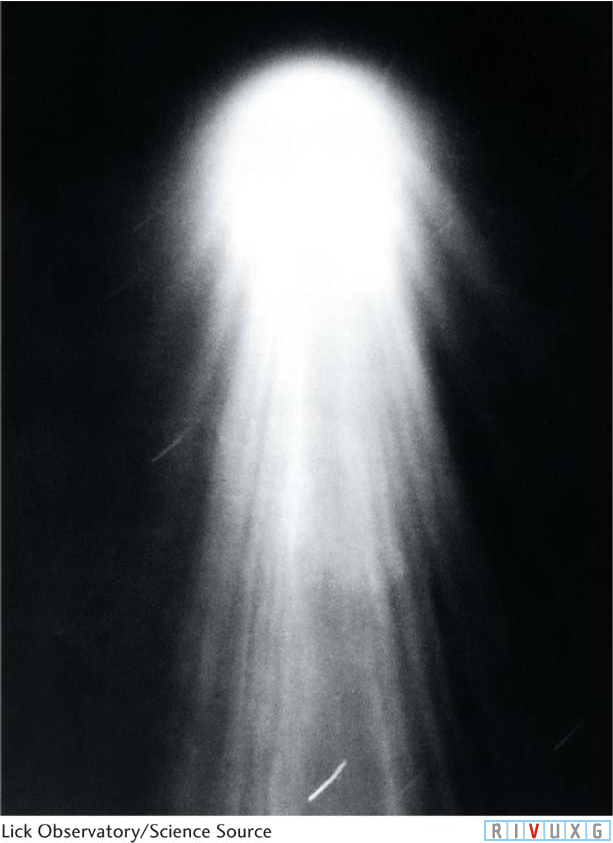
Figure 8-30:  The Head of Comet Brooks This comet had an exceptionally large, bright coma. Named after its discoverer, William R. Brooks, it dominated the night skies in October 1911.
The Head of Comet Brooks This comet had an exceptionally large, bright coma. Named after its discoverer, William R. Brooks, it dominated the night skies in October 1911.
8-8 Comets are fragile yet durable
To better understand the chemistry and structure of comets, astronomers sent the Deep Impact spacecraft, roughly the size of a small refrigerator, slamming into Comet Tempel 1 at 36,000 km/h (22,000 mi/h) in 2005 (Figure 8-32a–d). Observations indicate that the projectile gouged a crater 100 m (110 yd) across and 30 m (33 yd) deep. This collision sent up a cloud of vapor and melted rock estimated to have had a mass of 10 million kg (22 million lb), still less than a ten-millionth of the comet’s total mass. The particles ejected were typically smaller than 100 microns (μm).

Figure 8-32:  Visits to Comet Tempel 1 and Comet 67P (a) This composite image of Comet Tempel 1 has higher resolution at the bottom, as the projectile from Deep Impact headed in that direction. The smooth regions on the comet have yet to be explained. (b) Thirty seconds before the projectile struck the comet. (c) Seconds after impact, hot debris explodes away from the comet nucleus. The white horizontal half-ellipses are areas where the CCDs were overloaded with light from the event. (d) An image taken 67 seconds after impact. Within minutes, the cloud of debris became much larger than the entire nucleus. (e) Comet 67P/Churyumov-Gerasimenko as photographed by the Rosetta spacecraft in 2014. http://rosetta.jpl.nasa.gov/gallery/images/comet-67p/churyumov-gerasimenko
Visits to Comet Tempel 1 and Comet 67P (a) This composite image of Comet Tempel 1 has higher resolution at the bottom, as the projectile from Deep Impact headed in that direction. The smooth regions on the comet have yet to be explained. (b) Thirty seconds before the projectile struck the comet. (c) Seconds after impact, hot debris explodes away from the comet nucleus. The white horizontal half-ellipses are areas where the CCDs were overloaded with light from the event. (d) An image taken 67 seconds after impact. Within minutes, the cloud of debris became much larger than the entire nucleus. (e) Comet 67P/Churyumov-Gerasimenko as photographed by the Rosetta spacecraft in 2014. http://rosetta.jpl.nasa.gov/gallery/images/comet-67p/churyumov-gerasimenko
The size of the impact crater and the volume of matter ejected provide strong evidence that this comet is composed of very weakly bound fragments of rock and ice, rather than solid pieces of each. Spectra of the debris thrown upward revealed many organic molecules, that is, molecules containing carbon atoms. This finding supports the conjecture by some astronomers and geologists that comet impacts brought organic molecules to Earth early in our planet’s existence.
Even though this comet has an extremely low gravitational force with which to hold itself together, it managed to pull over 90% of the dust that it ejected back onto itself. The craters on this comet and others show that they have been hit by other pieces of space debris throughout their histories. The comet’s ability to essentially reform itself after this and other collisions helps explain why such objects have not all been annihilated over time.
To better understand comets and their evolution, the European Space Agency, in cooperation with NASA, sent the Rosetta spacecraft to rendezvous with Comet 67P/Churyumov-Gerasimenko (Figure 8-32e), which orbits the Sun every 6.45 years. The spacecraft arrived in August 2014. Rosetta deployed a lander in November of that year. The data acquired by both the spacecraft and lander are now being studied.
8-9 Comets do not last forever
Astronomers, many of them amateurs, typically discover at least a dozen new comets each year. Falling Sunward from the Kuiper belt, most are long-period comets, which have such eccentric orbits that they leave the inner solar system after one pass by the Sun and typically take tens of thousands up to millions of years to return. In 2006, astronomers observed the first comet whose orbit is so elliptical that it is believed to come from the Oort cloud. Called 2006 SQ372, this body has passed the orbit of Neptune on its way out to a maximum distance of 1600 AU from the Sun. This comet will return to the inner solar system in 22,500 years.
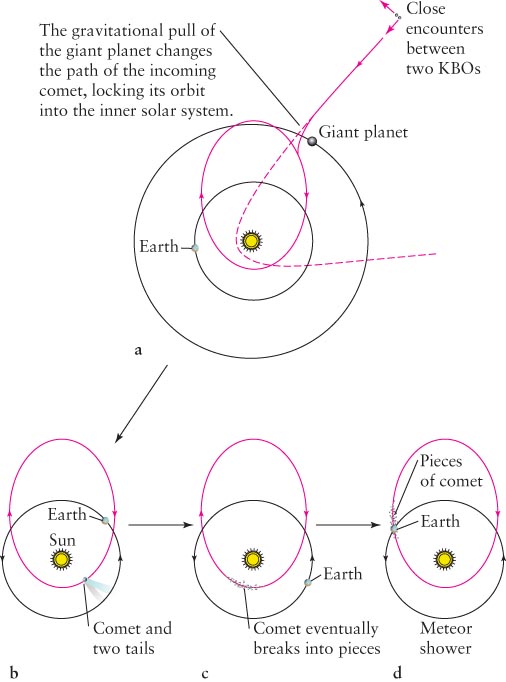
Figure 8-33: Transformation and Evolution of a Long-Period Comet (a) The gravitational force of a giant planet can change a comet’s orbit. Comets initially on highly elliptical orbits are sometimes deflected into more circular paths that keep them in the inner solar system. (b–d) These figures show the evolution of a comet into gas, dust, and rubble, and why debris from some of these comets strikes Earth (see also Figure 8-40).
Some of these long-period comets can become trapped in the inner solar system. The transformation of their orbits occurs in two different ways. First, a comet can pass so close to a giant planet that the planet’s gravitational force profoundly changes the comet’s orbit, slowing it down and trapping it in the inner solar system (Figure 8-33). Second, the comet can undergo a number of less significant gravitational encounters with planets and other bodies whose cumulative effect is also to trap the comet in the inner solar system. In either case, the long-period comet becomes a short-period comet, orbiting the Sun in fewer than 200 years. Like Comet Halley, short-period comets appear again and again at predictable intervals. Halley’s Comet has a 76-year orbit and will next pass close to the Sun in 2062.

Figure 8-34:  The Fragmentation of Comet Schwassmann-Wachmann 3 This comet, with a 5.4-year orbit, has been coming apart for decades. In 2006, it further fragmented after passing perihelion. One piece, Fragment B, shed at least 30 smaller pieces, shown here.
The Fragmentation of Comet Schwassmann-Wachmann 3 This comet, with a 5.4-year orbit, has been coming apart for decades. In 2006, it further fragmented after passing perihelion. One piece, Fragment B, shed at least 30 smaller pieces, shown here.
Comets cannot survive an infinite number of passages near the Sun. A comet’s first close encounter causes it to lose a large amount of its surface ice. In doing so, the dust it contains becomes a more significant part of its surface. This dust helps insulate it, reducing the amount of ice and dust the comet loses in subsequent close passages near the Sun. A typical comet is estimated to make between 60 and 100 passages to perihelion (closest approach to the Sun) before losing all of its ice. Because the rock and metal debris in a comet are held together by the ices in which they are imbedded, when the ices are gone, the solid pieces drift apart, many of them remaining in orbit around the Sun. Halley’s Comet has been seen at least 27 times, meaning that it has fewer than 73 more close passes to the Sun before it dissipates. Because it returns every 76 years or so, it will survive for about 73 × 76 = 5548 more years. A comet can also be torn apart when it comes too close to a planet or the Sun, or it can be destroyed completely by striking a planet, a moon, or the Sun. A spectacular example was Comet Shoemaker-Levy 9. As discussed in Section 7-3, that comet fragmented under the tidal force from Jupiter in 1992. Two years later, with the world’s astronomers watching carefully, the pieces returned and struck the planet (see Figure 7-10). Impacts on Jupiter by single objects were observed in 2009 and 2012.
Comet Shoemaker-Levy 9 broke up because its nucleus was held together very weakly, like Comet Tempel 1. As discussed previously, Shoemaker-Levy 9 may have been composed of separate pieces that had stuck together until Jupiter’s tidal force pulled them apart. Since then, astronomers have observed at least five other comets break up, in 1999, 2000 (Comet LINEAR), 2001, 2002 (Comet Toit-Neujmin-Delporte), and 2006 (Comet Schwassmann-Wachmann 3). Figure 8-34 shows a piece of Schwassmann-Wachmann 3 coming apart shortly after it passed perihelion. Soon thereafter, its remaining dust and rock fragments spread out in a loose collection of debris that continues to orbit the Sun along the comet’s path.
Focus Question 8-7
What evidence do we have that Comet Shoemaker-Levy 9 was not one solid chunk of rock surrounded by ice?
Comets occasionally lose mass quickly by ejecting it in bursts. Several times, starting in September 1995, astronomers observed Comet Hale-Bopp eject 7 to 10 times more mass than usual (Figure 8-35). Astronomers think that these events resulted from surface ice and dust being heated by the Sun and then being rapidly ejected from a local region on the comet’s surface, called a vent. Hale-Bopp rotates with a period of about 12 hours. The ejected matter therefore formed pinwheel-shaped distributions spiraling from the comet’s nucleus at a speed of 109 km/h (68 mi/h). Although the ejected matter did not represent a significant fraction of the comet’s mass, its light-reflecting dust made it look like a huge comet fragment.
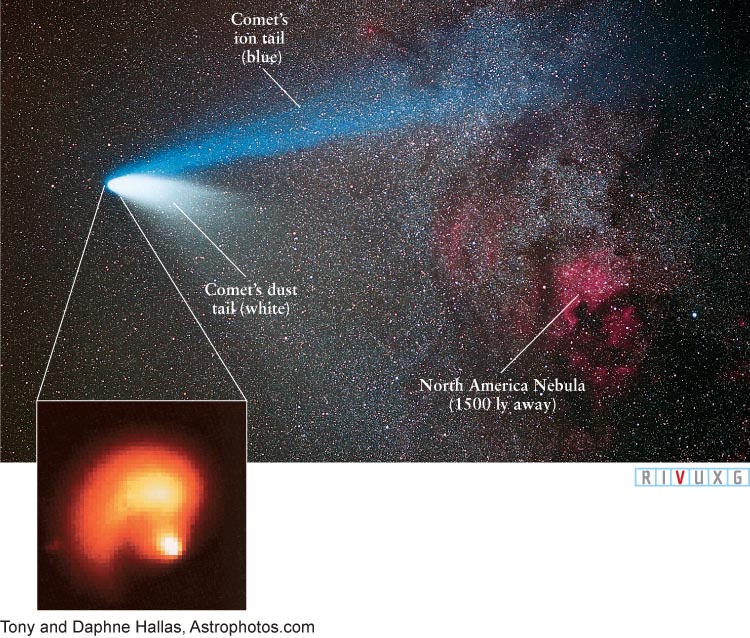
Figure 8-35:  Comet Hale-Bopp Discovered on July 23, 1995, this comet was at its breathtaking best in mid-1997. Inset: Jets of gas and debris were observed shooting out from Comet Hale-Bopp several times. This image shows the comet nucleus (lower bright region), an ejected piece of the comet’s surface (upper bright region), and a spiral tail. The ejected piece eventually disintegrated, following the same spiral pattern as the tail.
Comet Hale-Bopp Discovered on July 23, 1995, this comet was at its breathtaking best in mid-1997. Inset: Jets of gas and debris were observed shooting out from Comet Hale-Bopp several times. This image shows the comet nucleus (lower bright region), an ejected piece of the comet’s surface (upper bright region), and a spiral tail. The ejected piece eventually disintegrated, following the same spiral pattern as the tail.

Figure 8-36:  Sungrazing Comet Comet SOHO LASCO C3 is shown in the smaller box and magnified in the larger one. Discovered in March 2004, it was the 750th sungrazing comet discovered from the SOHO data. It completely sublimated near perihelion.
Sungrazing Comet Comet SOHO LASCO C3 is shown in the smaller box and magnified in the larger one. Discovered in March 2004, it was the 750th sungrazing comet discovered from the SOHO data. It completely sublimated near perihelion.
For thousands of years, astronomers have observed comets that pass very closely to the Sun. This was difficult, of course, because of the Sun’s brilliance, so only a few dozen had been carefully observed prior to the mid-1990s. Called sungrazing comets, they come within about 0.01 AU (1.46 × 106 km or 9.07 × 105 mi) of the Sun’s surface and are typically sublimated and thereby separated into smaller pieces near perihelion. At the end of the nineteenth century, Heinrich Kreutz observed that sungrazers all have the same orbit, indicating that they are pieces of a single comet that broke up perhaps centuries ago. They are called Kreutz comets in his honor. In 1995, the Solar and Heliospheric Observatory (SOHO) began a dedicated mission of observing the Sun and, among other things, locating sungrazing comets. To date, it has observed more than 1640 Kreutz comets (Figure 8-36).
The Sun is not the only star that has comets in orbit around it. A star labeled CW Leonis, about 500 ly from Earth, is presently enlarging in size and vaporizing billions of comets around it. Astronomers have observed the spectra of the water vapor from these cometary bodies.


 Kuiper Belt Objects (a, b) These 1993 images show the discovery (bracketed by white lines) of one of at least 1524 known KBOs. These two images of KBO 1993 SC were taken 4.6 hours apart, during which time the object moved against the background stars. (c) The KBO 1998 WW31 and its moon (lower left).
Kuiper Belt Objects (a, b) These 1993 images show the discovery (bracketed by white lines) of one of at least 1524 known KBOs. These two images of KBO 1993 SC were taken 4.6 hours apart, during which time the object moved against the background stars. (c) The KBO 1998 WW31 and its moon (lower left).


 Comet Nuclei (a) This image, taken by the Giotto spacecraft, shows the potato-
Comet Nuclei (a) This image, taken by the Giotto spacecraft, shows the potato-


 Comet Wild 2 (a) This picture shows two images combined. One is a high-
Comet Wild 2 (a) This picture shows two images combined. One is a high-
 Comet Hale-
Comet Hale-
 The most visible and inspiring features of comets are their long, flowing, diaphanous tails (Figure 8-
The most visible and inspiring features of comets are their long, flowing, diaphanous tails (Figure 8-

 Comet West Astronomer Michael M. West first noticed this comet on a photograph taken with a telescope in 1975. After passing near the Sun, Comet West became one of the brightest comets of the 1970s. This photograph shows the comet in the predawn sky in March 1976.
Comet West Astronomer Michael M. West first noticed this comet on a photograph taken with a telescope in 1975. After passing near the Sun, Comet West became one of the brightest comets of the 1970s. This photograph shows the comet in the predawn sky in March 1976.


 The Two Tails of Comet Mrkos (a) Comet Mrkos dominated the evening sky in August 1957. These three views, taken at 2-
The Two Tails of Comet Mrkos (a) Comet Mrkos dominated the evening sky in August 1957. These three views, taken at 2-

 The Tail of Comet Ikeya-
The Tail of Comet Ikeya-
 The Head of Comet Brooks This comet had an exceptionally large, bright coma. Named after its discoverer, William R. Brooks, it dominated the night skies in October 1911.
The Head of Comet Brooks This comet had an exceptionally large, bright coma. Named after its discoverer, William R. Brooks, it dominated the night skies in October 1911.

 Visits to Comet Tempel 1 and Comet 67P (a) This composite image of Comet Tempel 1 has higher resolution at the bottom, as the projectile from Deep Impact headed in that direction. The smooth regions on the comet have yet to be explained. (b) Thirty seconds before the projectile struck the comet. (c) Seconds after impact, hot debris explodes away from the comet nucleus. The white horizontal half-
Visits to Comet Tempel 1 and Comet 67P (a) This composite image of Comet Tempel 1 has higher resolution at the bottom, as the projectile from Deep Impact headed in that direction. The smooth regions on the comet have yet to be explained. (b) Thirty seconds before the projectile struck the comet. (c) Seconds after impact, hot debris explodes away from the comet nucleus. The white horizontal half-

 The Fragmentation of Comet Schwassmann-
The Fragmentation of Comet Schwassmann-
 Comet Hale-
Comet Hale-
 Sungrazing Comet Comet SOHO LASCO C3 is shown in the smaller box and magnified in the larger one. Discovered in March 2004, it was the 750th sungrazing comet discovered from the SOHO data. It completely sublimated near perihelion.
Sungrazing Comet Comet SOHO LASCO C3 is shown in the smaller box and magnified in the larger one. Discovered in March 2004, it was the 750th sungrazing comet discovered from the SOHO data. It completely sublimated near perihelion.